
Insects and Ticks > Ticks
Ticks are well known bloodsucking external parasites of humans, pets, livestock, and wild animals. They also are vectors of a wide variety of disease-causing organisms to animals and are second only to mosquitoes in terms of public health importance. You are encouraged to learn more about the biology of ticks in Indiana. This will enable you to make more informed decisions about health risks, avoid contact with ticks, decide whether to attempt tick control, and determine how to conduct control when deemed necessary.
What is the Public Health Risk of Ticks?
The majority of tick species in Indiana feed on wild animals and livestock, but some species feed on humans and are vectors of several diseases that are mentioned below. See Purdue Extension publication E-244-W "Lyme Disease" (PDF 834KB) for details about Lyme disease. In addition, female ticks that attach and suck blood near the spinal cord can produce a condition known as "tick paralysis" in livestock, pets, and humans.
How Can I Recognize a Tick?
Ticks are wingless and possess a single, oval body region that is relatively flat (except when filled with blood). Adults and nymphs have eight legs; larvae have only six legs. The so-called "head" of a tick includes structures involved in feeding, together known as the "capitulum." It consists of a pair of leg-like sensory structures known as "palps" that enable the tick to detect an approaching host, a pair of knife-like structures known as "chelicerae" that cut an opening in the host skin, and a single barbed structure known as a "hypostome" that enters this opening. The hypostome becomes anchored in the host flesh when the tick takes a blood meal.
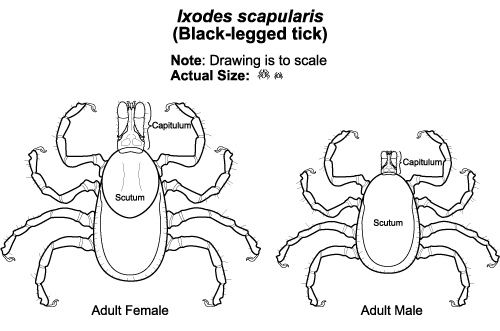 Unfed adult hard ticks, based on a species of Ixodes.
Unfed adult hard ticks, based on a species of Ixodes.Illustration by: Scott Charlesworth, Purdue University
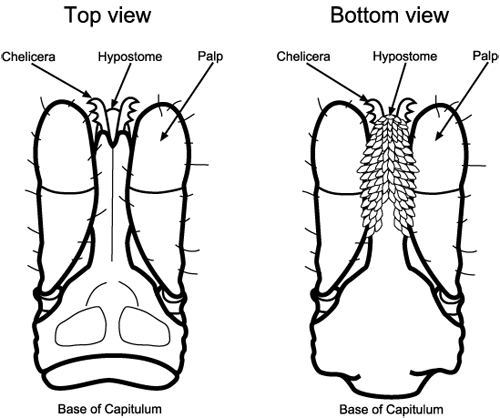 Generalized mouthparts of a hard tick, based on a species of Ixodes.
Generalized mouthparts of a hard tick, based on a species of Ixodes.Illustration by: Scott Charlesworth, Purdue University
How Many Kinds of Ticks Are There?
There are an estimated 899 species of ticks in the world, of which over 90 occur in the continental U.S. About 80 species are in the family Ixodidae, known as "hard ticks," and about 10 species are in the family Argasidae, known as "soft ticks." Approximately 15 species of ticks have been documented in Indiana, including four species of hard ticks that are of significance to public health:
- Dermacentor variabilis (American dog tick, also known as the "eastern wood tick")
- Amblyomma americanum (lone star tick)
- Ixodes scapularis (black-legged tick, also known as "deer tick" or "lyme disease tick")
- Rhipicephalus sanguineus (brown dog tick)
What Are The Differences Between Hard Ticks And Soft Ticks? |
||
| Feature | Hard Tick | Soft Tick |
|---|---|---|
| Scutum (dorsal shield) |
present | not present |
| Capitulum (mouth parts) |
anterior, visible from above |
ventral, not visible from above |
| Nymphal stages | one | several |
| Adult feeding time | several days | 30-60 min. |
| Female blood meals | one | several |
| Egg laying events | one | several |
| Total eggs laid | 3,000-8,000 | 400-500 |
What Is the Life Cycle of Hard Ticks in Indiana?
Hard ticks have four developmental forms: an egg stage; a larval stage; a nymphal stage; and female and male adults. The vast majority of hard tick species are known as "3-host ticks," with the following general life cycle. A newly hatched larva feeds on a host, drops off to the ground, and molts to a nymph. A nymph seeks out and feeds on a second host, drops off to the ground, and molts to an adult. Male and female adults seek out a third host, feed, mate, and drop off to the ground. Males die soon thereafter, while females eventually lay eggs on the soil. The duration of egg laying may last several days to a few weeks. Depending on the species, a single female may lay 3,000 - 8,000 eggs and then dies.
The life cycles of hard ticks differ depending on several factors, such as the type of hosts on which they feed, the length of each developmental stage, which developmental stage survives winter, and how long it takes to complete a life cycle. For example, depending on the species, hard ticks may spend winter either as larvae, nymphs, or female adults. A few species may have two or three developmental stages that over-winter. Some species complete a life cycle in as few as 90 days, others take a year, and a few require two years to complete a life cycle.
 Life cycle of a 3-host hard tick, based on Dermacentor variabilis (American dog tick).
Life cycle of a 3-host hard tick, based on Dermacentor variabilis (American dog tick).Illustration by: Scott Charlesworth, Purdue University
Nearly every tick the public encounters is an adult hard tick, and usually a female. The reason is that female hard ticks attach to a host, feed for several days, and engorge to a size that is easily felt or seen on a person or pet. In contrast, soft ticks almost never are seen by the public since they feed quickly and typically do so in the den, burrow, or nest of the host. Only one species of soft tick occurs in Indiana, Carios kelleyi (formerly Ornithodoros kelleyi). The larvae, nymphs, and adults are parasites of bats and exist in their roosting area, but an occasional adult may be encountered in a building that has been inhabited by bats, especially if the bats are permanently removed.
 An example of a habitat (hardwood forest with thick leaf litter) in which Ixodes scapularis (Black-legged tick) can be abundant.
An example of a habitat (hardwood forest with thick leaf litter) in which Ixodes scapularis (Black-legged tick) can be abundant.Photo by: John MacDonald, Purdue University
Where Are Hard Ticks Found?
Hard ticks are found in habitats that support large numbers of vertebrate hosts, such as mammals, ground-dwelling birds, and lizards. Some of the most productive habitats are moist woodlands and areas of vegetation around the edge of forests, along forest trails, and in grassy fields. Additional habitats include areas surrounding power line routes made through forests, in and around campgrounds, and in abandoned grassy yards in urban areas. Ticks also are found in tall grass associated with interstate rest areas where pets are allowed to walk.
How Do Hard Ticks Find a Host?
Being flightless, hard ticks "wait" for passing vertebrate hosts. Larvae, nymphs, and adults detect carbon dioxide, host odors, vibrations, and warm, moist air currents. Tick larvae usually remain on the ground, where they encounter potential hosts. Their most common hosts are small mammals, especially mice, and ground-dwelling birds, but larvae of some species feed on humans. Nymphs remain on the ground or climb grassy vegetation from which they are able to grasp a passing host. They tend to feed on small to medium-sized mammals, but nymphs of a few species are attracted to larger hosts, including pets and humans. Adult ticks may remain on the ground, but more commonly climb up vegetation, from which they grasp a passing host. They often can be seen at the tops of grass blades or on lower leaves of bushes engaging in "questing." Questing is a behavior in which the tick reaches upward with waving front legs ahead of an approaching host. Adult ticks tend to feed on larger mammalian hosts such as deer, livestock, dogs, and humans.
How Do Hard Ticks Feed?
The act of blood feeding by a hard tick results in a "feeding wound." As it begins to feed, a tick secretes saliva containing compounds that increase blood flow, prevent clotting, and suppress the host's immune response. Ticks imbibe the blood that pools in the wound. At the same time, they regurgitate excess water that has been extracted from the blood meal into the wound. This process increases the possibility for the transmission of pathogens from a tick to its animal host. Transmission of a pathogen typically does not occur until an infected tick has attached and fed for at least 24 hours, and transmission of some pathogens does not begin until an infected tick has fed for 48 hours or more.
Larvae of hard ticks usually complete a blood meal within a day or two and engorge very little. Nymphs attach to a host and complete a blood meal within a few days. They engorge enough so that red blood can be seen through their body wall. Male adults feed much like nymphs, but do so repeatedly on one host animal. The large scutum greatly limits the amount of engorgement by male adults. Female adults attach to a host and, once mated, feed to completion in a week or so. Engorgement is dramatic over the course of the last day or two of feeding, resulting in a huge increase in body size. Engorgement of female adults is facilitated by the lack of a large scutum and the possession of an expandable body wall. Fully engorged females of certain species may be over half an inch long and a quarter inch wide.
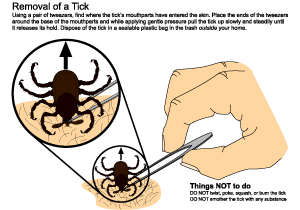 Recommended procedure for removal of an attached tick.
Recommended procedure for removal of an attached tick.Illustration by: Scott Charlesworth, Purdue University
What Is the Best Way to Remove a Hard Tick?
The safest and most effective way to remove an attached tick is to grasp it behind the mouthparts with forceps and pull gently and steadily until the tick releases its hold. Latex or similar types of skin-tight gloves may be used. Other types of gloves may be less effective and less safe because they may squash the tick, releasing body fluids that may harbor pathogens directly into the feeding wound. The attachment site of the tick should be washed thoroughly with warm soapy water and rubbing alcohol to remove any possible pathogens. The removed tick should be saved for identification or disposed of in a sealable plastic bag in the garbage or flushed down a toilet.
Recall that the barbed mouthparts of the tick help to anchor it in the flesh of its host. In addition, ticks secrete compounds in their saliva that help to cement them in the feeding wound. Pulling too strongly or twisting while attempting to remove a tick may result in tearing of the tick, leaving the hypostome embedded in the skin. This can lead to bacterial infection in the feeding wound and, potentially, to the risk of contamination of the feeding wound by tick body fluids that may harbor pathogens.
Do not attempt to remove an attached tick with caustic chemicals or by applying heat. This can kill the tick before it disengages its mouthparts. It can also cause the tick to regurgitate into the feeding wound and therefore increase the chance of transmitting a pathogen.
How Can Tick Bites be Prevented?
The best way to prevent tick bites is to avoid certain habitats during the peak of tick season. In Indiana, this is usually from early April into July. If you do need to enter an area that is a likely or confirmed tick habitat, wear light-colored clothing, including a long-sleeved shirt tucked into pants and long-legged pants tucked into socks. This will not only help to prevent ticks from reaching your body, it will also enable you to spot any adult ticks on your clothing.
Apply a repellent containing DEET, and consider treating clothing with permethrin, which initially repels and eventually kills ticks that contact clothing, see Purdue Extension publication E-71-W "Ticks - Biology and Their Control" (PDF 372KB) and the Centers for Disease Control and Prevention for additional information on repellents and their correct use. Follow directions for use printed on the product label.
As soon as possible after an outing in tick habitat, remove clothing and conduct a thorough check of it and your body. Male and female adult ticks can wander on a host for up to several hours before they attach. This is why a thorough body check, paying particular attention to areas such as the head, underarm, and groin, can discover adult ticks before they begin to feed. Keep in mind, however, that larvae and nymphs rarely are seen because they are very small and usually translucent. This is why the preventative measures outlined above should be followed.
What Should I Know About the Species of Ticks of Public Health Importance?
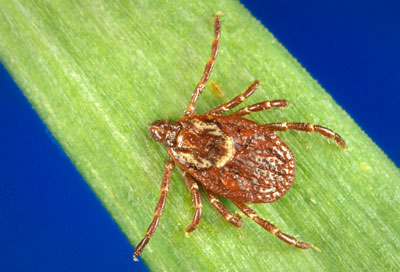 Female adult of Dermacentor variabilis (American dog tick).
Female adult of Dermacentor variabilis (American dog tick).Photo by: James Gathany, Center for Disease Control and Prevention
Dermacentor variabilis: The American dog tick is found throughout the eastern U.S., in Colorado, and the Pacific Northwest. It occurs in all 92 Indiana counties and can be very abundant in certain habitats some years. Adults are characterized by creamy-grey markings on the scutum and by short mouthparts. Larvae and nymphs feed on small mammals, especially meadow mice, and are seldom seen by people. Adults appear in April, reach peak numbers in June, and are seldom seen after early July. They feed on a wide range of mammals, including deer and other wild animals, livestock, pets, and humans. A female may lay over 6,000 eggs before she dies.
The American dog tick is the most common tick found on humans and dogs in the state. Engorgement by adult females has been associated with tick paralysis. This species is the primary vector of spotted fever and also can be a vector of the diseases tularemia and anaplasmosis. Evidence to date does not support involvement in the transmission of Lyme disease, but researchers continue to pursue this possibility.
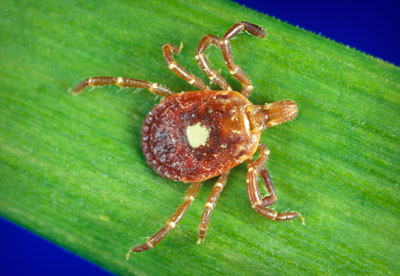 Female adult of Amblyomma americanum (lone star tick).
Female adult of Amblyomma americanum (lone star tick).Photo by: James Gathany, Center for Disease Control and Prevention
Amblyomma americanum: The lone star tick occurs across the southeastern and south-central U.S. It is most common in southern Indiana, but is found throughout the state, most commonly in moist woodlands. Adult females are characterized by a pearly-white spot at the tip of the scutum and by long mouthparts. A wide range of animal hosts serve as a source of blood, including ground-dwelling birds, small mammals, and large mammals such as deer, livestock, and pets. All developmental stages of the lone star tick feed readily on humans. Larvae, which sometimes are referred to as "seed ticks" or "turkey ticks," appear in spring and again in fall. The nymphs of this species over-winter and are active from April into July. Adults also over-winter and are active from late March into June. A female can lay over 8,000 eggs before she dies.
The lone star tick is the second most common tick found on humans especially in southern Indiana. The long, barbed hypostome of female adults inflicts a deep feeding wound, and engorging females have been associated with tick paralysis. This species is a vector of spotted fever, and two recently recognized diseases, ehrlichiosis and Southern tick-associated rash illness (STARI).
 Female adult of Ixodes scapularis (black-legged tick).
Female adult of Ixodes scapularis (black-legged tick).Photo by: James Gathany, Center for Disease Control and Prevention
Ixodes scapularis: The black-legged tick occurs throughout the eastern U.S., and can be locally abundant in moist woodlands with thick leaf litter. Adults are significantly smaller than Amblyomma and Dermacentor ticks and have a characteristic uniform deep mahogany color. Female black-legged ticks are somewhat tear drop-shaped and have long mouthparts. Males are smaller than females and have shorter mouthparts. Specimens of the black-legged tick were first collected in Porter County, Indiana in 1987. It has increased its range since then, but appears to be much more abundant in the northwest quadrant of the state than in eastern and southern counties.
Until relatively recently, ticks found in the northeastern U.S. were considered by a few researchers to be a different species they named Ixodes dammini, and this scientific name appears in older articles pertaining to Lyme disease. However, detailed study of anatomy and biology by tick researchers revealed that "Ixodes dammini" and Ixodes scapularis are the same species, a finding accepted by nearly all scientists who study ticks and Lyme disease.
The black-legged tick has a very wide host range. Specimens have been collected on 57 species of birds, 41 species of mammals, and 11 species of lizards. Black-legged tick larvae feed primarily on white-footed mice and are most abundant from July into September. Nymphs feed primarily on a variety of small, ground-dwelling vertebrates, but also feed on humans and pets. Nymphs are most abundant from late spring into early summer. Adults feed readily on deer, and deer are very important to the reproductive success and spread of the black-legged tick within the state. Adults are found in late summer into fall and again in early spring. A female lays about 3,000 eggs before she dies.
Adult black-legged ticks are rarely found on humans, but they do feed on dogs and cats. Nymphs appear to be the main vectors of Lyme disease to humans and pets. Nymphs are approximately the size of a poppy seed and are therefore almost never seen by a human. For this reason, people entering areas in which Lyme disease is transmitted are strongly encouraged to wear proper clothing and to use a repellent. In addition to Lyme disease, the black-legged tick is a vector of human anaplasmosis and babesiosis. More information on Ixodes scapularis is available from Purdue Extension publication E-244-W "Lyme Disease." (PDF 834KB)
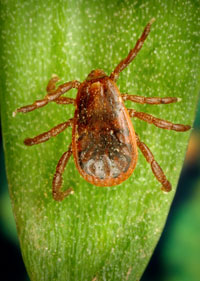 Female adult of Rhipicephalus sanguineus (brown dog tick).
Female adult of Rhipicephalus sanguineus (brown dog tick).Photo by: James Gathany, Center for Disease Control and Prevention
Rhipicephalus sanguineus: This species is a worldwide pest of dogs and occurs in the southern U.S. It is not native to Indiana, but has been repeatedly introduced into the state via infested dogs. Adults are small, uniformly brown, and have short mouthparts. Dogs are the primary host for larvae, nymphs, and adults, all of which conceal themselves in cracks and crevices near where dogs bed down. This is the only tick species in Indiana that can reproduce indoors and is capable of colonizing homes and heated kennels. A female can lay about 4,000 eggs before she dies.
Larvae, nymphs, and adults of the brown dog tick rarely feed on humans, but infestations in kennels and homes are disconcerting when large numbers are seen crawling up walls, curtains, and on furniture. This species is a vector of a dog disease known as "canine ehrlichiosis."
The brown dog tick has not been known to transmit a disease-causing agent of humans in the U.S. However, a recent outbreak of spotted fever in Arizona appears to have been associated with the brown dog tick, based on a research publication by Demma, L. J., et. al., in 2005, "Rocky Mountain spotted fever from an unexpected tick vector in Arizona" that was published in the New England Journal of Medicine. The authors found that homes of several patients were infested with brown dog tick larvae, nymphs and adults, many of which were infected with Rickettsia rickettsii, the bacterium that causes spotted fever.
Where Can I Find More Information on Ticks?
Numerous Web sites provide information on tick biology and control. The following Web sites are recommended as accurate and current sources of information.
